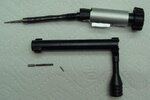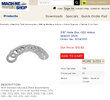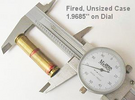Sure is, loaded it for a short while.I load 5.7x28 and the amount that the shoulder moves on each firing is insane.
You are using an out of date browser. It may not display this or other websites correctly.
You should upgrade or use an alternative browser.
You should upgrade or use an alternative browser.
Hornady Head Space Comparater
- Thread starter nettlle
- Start date
jmorris
Member
- Joined
- Sep 30, 2005
- Messages
- 24,162
Only trying to minimize the damage to the brass. Have not done well at minimizing movements by my use of a small base die.
Making the base undersize or smaller than necessary won't minimize movements.
Using a comparator will allow you to measure the difference of the settings in this video but not having one doesn't keep me from hitting the setting I want.

Setting size die for bolt action rifle.
Varminterror
Member
- Joined
- Jul 17, 2016
- Messages
- 14,893
I will disagree with you on this one.
I load 5.7x28 and the amount that the shoulder moves on each firing is insane.
On my first attempt to reload 5.7x28 I tried to push the shoulder back to where it was supposed to be and my die wouldn't do it.
I had to remove 0.002" off the bottom of the die to get it there.
My comparator set didn't have a small enough bushing to accomodate the 5.7x28 cartridge so I used a 26 cal bushing.
Without a comparator there was no simple way to calcualte how far to push the shoulder back.
I also use one for setting up my sizer for my M1A National Match to work the brass the least amount possible
In both of these use cases, you could accomplish the same task - making ammo to fit your chamber, with a sizing die and the rifle.
Varminterror
Member
- Joined
- Jul 17, 2016
- Messages
- 14,893
In fact I do use the above in actual practice.
You use the tool - that’s fine. But your comparison made between the two scenarios - suggesting that a comparator is necessary to be able to set shoulder bump specifically to individual rifles and without a comparator, only generic ammunition can be made - is false.
Brass can be sized to any desired shoulder bump possible for the die and shellholder combination, to be ideally fit to the rifle chamber, with or without comparators.
Lefty38-55
Member
I am banging away with a 308 M1A and have read that brass life is only 3-4 reloads.
M1A - Off-topic a bit, yes ... but look up Larry Gibson's result of using the special RCBS 'X' sizing die for semi-auto rifles, as he got > 16 reloads out of M1A cases without any trimming. He only stopped the testing @ 16 as he figured that was quite good enough ... expanding his useful case life by a 4X factor! I use one for my precision 5.56mm loads and it's excellent!We may have a diverging concept here.... that gun [M1A] is very hard or brass and minimizing brass movements will help, but it's not a one stop shop for lifetime
Hornady Comparator - LOVE it for precision reloads, can also use to determine the free bore in a barrel, plus for setting the bullet jump; very useful for VLD bullets. Like others said, size to YOUR chamber.
thump_rrr
Member
I have more than one firearm in that caliber.In both of these use cases, you could accomplish the same task - making ammo to fit your chamber, with a sizing die and the rifle.
It would certainly be easy to do this in a bolt action rifle because of the feel of closing the bolt.
Not as easy to do in a pistol or a PS90.
Can it be done, of course but you can also load ammo without a set of vernier calipers or an OAL Gauge or many other things but that’s what separates us from the animals.
In reality all you need is a Lee Loader and a piece of wood.
Last edited:
Varminterror
Member
- Joined
- Jul 17, 2016
- Messages
- 14,893
In reality all you need is a Lee Loader and a piece of wood.
Devolving to this particular strawman doesn’t make sense either, and is again a false paradigm of comparison. The Lee Loaders are neck sizing dies, which inherently bring potential for failed feeding with progressive firings, as they don’t size the body of the case at all, nor does it offer any adjustability for sizing - no control for shoulder/headspace dimension. So Lee Loaders cannot do what is being described in this thread for proper shoulder/headspace sizing, and we need more than just a Lee Loader and a piece of wood to do so - but proper shoulder/headspace sizing CAN be accomplished with or without comparators.
'Fraid not.suggesting that a comparator is necessary to be able to set shoulder bump specifically
to individual rifles and without a comparator, only generic ammunition can be made - is false.
Of course one can do it, but I would have to ask the point of reference (actual measurement
value for the record books) when changing from rifle to rifle.
As the other Gentle Readers might imagine, I do recommend the comparator... for any number
of reasons
SixShooterBP
Member
Read my response above. Rear locking actions with excessive case stretch are another example where blind use of a comparator instead of using the actual rifle can lead to improper set up of the die, and then feeding and extraction can be compromised.
Wouldn’t you be taking the actual dimensions when measuring the cases fired from the rifle using the comparator?
One does not use a comparator blind.
While on that note, what is the preferred case dimension procedure on a rear lock-up action -- if not "Kiss on-Close" minus a couple of thou ?
In that case (pun intended) use the comparator to establish K-o-C dimension as point of departure, and go from there.
While on that note, what is the preferred case dimension procedure on a rear lock-up action -- if not "Kiss on-Close" minus a couple of thou ?
In that case (pun intended) use the comparator to establish K-o-C dimension as point of departure, and go from there.
Varminterror
Member
- Joined
- Jul 17, 2016
- Messages
- 14,893
Wouldn’t you be taking the actual dimensions when measuring the cases fired from the rifle using the comparator?
Instructions included with the Hornady tool describe measuring fire formed brass and reducing length by 1-2 thou. Unfortunately, certain action types, such as rear lockers or semiautos, can yield fired brass which is actually longer than the dead length headspace measurement. So pushing back those fire formed cases by 1-2 thou does not actually produce 1-2 thou chamber clearance.
In the opposite case, not all brass will grow to perfectly match the chamber dimensions when fired, and would freely close when reinserted into the chamber, such when pushing THESE cases back the suggested 1-2 thou, we actually end up with MORE clearance than desired.
We can get the same fit to chamber by using the rifle itself to set the die, without comparators. The comparator is a fun tool, but it’s not a necessity in any reloading processes.
Varminterror
Member
- Joined
- Jul 17, 2016
- Messages
- 14,893
Of course one can do it, but I would have to ask the point of reference (actual measurement
value for the record books) when changing from rifle to rifle.
Why do you need to use ammo dimensions for one rifle to set a die for another?
You promoted that comparators were the only way to make properly fit ammo for unique chambers, which then you acknowledge wasn’t true in your last, and now you’re saying the comparator is pertinent for making generic ammo to fit multiple rifles… pick a lane, dude…
Millions of reloaders make properly fit ammunition which ideally fits their chambers without comparators, have for generations, and will for generations more.
JFrank
Member
I don’t strip the bolt, never really got comfortable doing it so I use the L&L tool from Hornday. I have a fire formed case modified to use in the tool for monitoring seating depth. I use the comparator/ inserts for setting my sizing die also sorting bullets by changing inserts to match ogive diameters.
I find it quick and easy with enough accuracy to get the job done.
I find it quick and easy with enough accuracy to get the job done.
If one does not understand why two (or three) different case headspace dimensions for two (or three)Why do you need to use ammo dimensions for one rifle to set a die for another?
different rifles requires the dies to be set differently between loading sessions, I can explain no further.
But this discussion has now gone somewhat pedantic.
If the Gentle Readers would like a simple/repeatable digital method to both establish and change case
sizing/dimensions, between both rifles and different brass conditions/manufacturers I recommend getting/-
using a comparator.
If the Gentle Readers don't... don't.
JFrank
Member
I’ve just never been a bolt stripper, lots of guys are but I’m afraid of small parts getting lost.I stripped the bolt for finding the lands to start. I started at .020 off the lands, and never chased them on that barrel.
View attachment 1200545
I find it a valuable tool. It works great for converting .223/5.56 brass for 300 blackout. I can measure shoulders on factory ammo, check fired cases in my rifles and adjust my dies when forming fired brass. Different brands size differently with the same die setting and resizing fired cases die adjustments are different than forming cases. I use it to check most all brass from several calibers. Already good info on proper shoulder setback. Also for a belted magnum it will give me a reading on how much to push the shoulders back. If full length resizing with contact with the shellholder I get case stretching and only 3-4 loads safely but using my comparator I get more and safer firings with the super expensive belted brass. A very useful tool in my opinion and better than a chamber gauge. I really like my one RCBS Precision Mic but the Hornady Comparator is less expensive and more versatile.
Last edited:
Varminterror
Member
- Joined
- Jul 17, 2016
- Messages
- 14,893
different rifles requires the dies to be set differently between loading sessions
Here are a couple of lead measure process tools rather than using the sized brass as a lag measure to reset dies. These eliminate the need to size, measure, size again, measure again for every time you move a die.
*I prefer to buy a sizer for each rifle so I avoid any reason to reset dies back and forth, but these tools work.
Depth spindle on the caliper used to measure the die body height over the press:
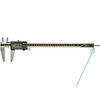
Forster Accu-adjust lock ring - each mark here is 0.001” (1/32 of a turn is 2 thousands, even without indicator marks)
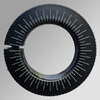
Whidden Click Adjust lock ring - each click is 1 thou:
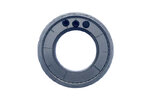
@jmorris put together this handy DIY height gauge, doing the same thing which can be done with the depth spindle of a caliper.
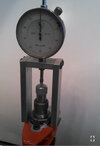
So again, comparators aren’t the only way, or even the best way to reset sizing dies. They’re a handy tool, and apparently having some reference number for the length of a string makes some people feel safer, but comparators aren’t actually necessary for any reloading process.
Varminterror
Member
- Joined
- Jul 17, 2016
- Messages
- 14,893
JFrank
Member
I once dated a stripper, does that count ?C’mon, Jim - you gotta strip dat bolt like you’re tryin’ to pay for college!!
View attachment 1200629
jmorris
Member
- Joined
- Sep 30, 2005
- Messages
- 24,162
I once dated a stripper, does that count ?
Only if you've got photos to prove it.
Edit: from back then.....
WeekendReloader
Member
I use the comparator to measure the overall length of a case from base to ogive. I determine what that distance should be by stripping the bolt so it closes with no resistance. Then I resize a fired case, shortening it by a thousandth or two, until the bolt closes easily on the case in the chamber. Usually I'll size two other cases, one slightly shorter and one slightly longer to verify the correct case length. Then, for precision rounds, I check every case I resize to ensure they are the correct length. With rounds like Remington 223, I just resize the case to SAAMI length.
Nature Boy
Member
- Joined
- Apr 21, 2015
- Messages
- 8,253
Some of us like to have more control/sleep better at night.
I want all of reloads exactly the same as the ones before.
Both of these sum up my feelings on the subject
Similar threads
- Replies
- 11
- Views
- 1K
- Replies
- 11
- Views
- 2K
- Replies
- 14
- Views
- 4K


